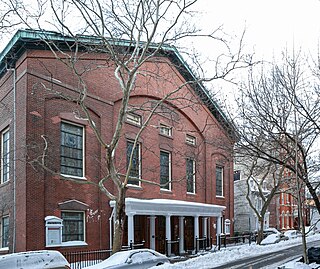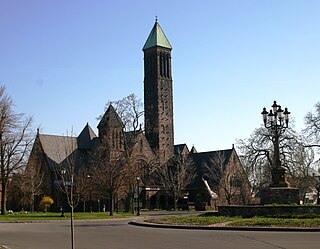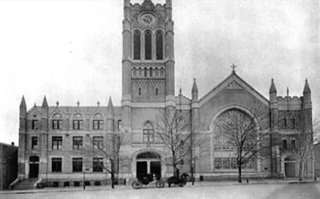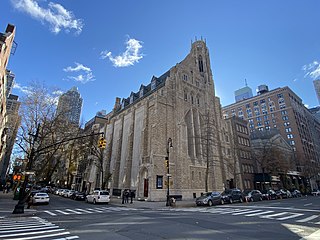
Plymouth Church is an historic church located at 57 Orange Street between Henry and Hicks Streets in the Brooklyn Heights neighborhood of Brooklyn, New York City; the Church House has the address 75 Hicks Street. The church was built in 1849–50 and was designed by Joseph C. Wells. Under the leadership of its first minister, Henry Ward Beecher, it became the foremost center of anti-slavery sentiment in the mid-19th century. It has been listed on the National Register of Historic Places since 1961, and has been a National Historic Landmark since 1966. It is part of the Brooklyn Heights Historic District, created by the New York City Landmarks Preservation Commission in 1965.

Calvin Presbyterian Church is a Presbyterian Church in Canada congregation in the Deer Park area of Toronto, Ontario, Canada. The church building is located at 26 Delisle Avenue, close to Yonge Street and St. Clair Avenue.

The Peoples Church of East Lansing is an interdenominational Protestant congregation located in the city of East Lansing, Michigan. It is officially a member of the American Baptist Churches USA, the Presbyterian Church (U.S.A.), the United Church of Christ, and the United Methodist Church. The congregation's membership currently numbers around 1,300.
These congregations are affiliated with one of the five associations comprising the Heartland Conference of the United Church of Christ. They are listed in order of association.

Archwood United Church of Christ, formerly known as Archwood Avenue Congregational Church, is a church located at 2800 Archwood Avenue in the Brooklyn Centre neighborhood of Cleveland, Ohio, in the United States. The structure is the home of the Archwood United Church of Christ, one of the oldest Christian congregations in Cleveland. It was listed in the National Register of Historic Places on May 13, 1993.

Avenue St. Andrew's is a United Reformed Church in Southampton, England. Part of the church building is Grade II listed.

The National Presbyterian Church is a Christian congregation of approximately 1,500 members of all ages from the greater metropolitan Washington, D.C., area. The mission statement of the church is "Leading People to Become Faithful Followers of Jesus Christ Together in God’s World"

Fifth Avenue Presbyterian Church is a Presbyterian Church (U.S.A.) church in New York City. The church, on Fifth Avenue at 7 West 55th Street in Midtown Manhattan, has approximately 2,200 members and is one of the larger PCUSA congregations. The church, founded in 1808 as the Cedar Street Presbyterian Church, has been at this site since 1875.
Mount Moriah Missionary Baptist Church was founded in 1886 and was the first black Baptist church organized in Winter Park, Florida, United States. Originally, the church began at the home of Reverend Charles and Mrs. Missouri Ambrose on Pennsylvania Avenue in the town's predominantly African American Westside.

The First Presbyterian Church in Buffalo, New York was the first organized religious body formed in what was then the western frontier of New York State. The town of Buffalo was sparsely populated when the church was organized on February 2, 1812. However, having survived the War of 1812, the town of Buffalo was rebuilt and rapidly grew with the completion of the Erie Canal in 1825. The first two buildings were located on the same downtown lot. However, the congregation relocated between 1889 and 1891 to its present location approximately one and-a-half miles to the north in a more residential area.
West Presbyterian Church was a congregation and two houses of worship in Manhattan, New York City. The congregation was founded in 1829 and merged in 1911 with Park Presbyterian Church to form West-Park Presbyterian Church. The first house of worship, also known as the Carmine Street Presbyterian Church, in Greenwich Village, was used from 1832 to 1865, and the second, on West 42nd Street between Fifth Avenue and Sixth Avenue, from 1865 until 1911, when it was sold and demolished. Proceeds from the sale were used, in accordance with the merger agreement, to build and endow a church for an underserved neighborhood, Washington Heights: Fort Washington Presbyterian Church. In addition, the West Church congregation had earlier established two mission churches which eventually merged to become Good Shepherd-Faith Presbyterian Church. West-Park, Fort Washington, and Good Shepherd-Faith are all active today.

The congregation of North Presbyterian Church, at 525 West 155th Street in Manhattan, New York City, is a combination of three former congregations: North Presbyterian Church, Washington Heights Presbyterian Church, and St. Nicholas Avenue Presbyterian Church.

The Fourth Presbyterian Church of Chicago is one of the largest congregations of the Presbyterian Church (U.S.A.), located in the Magnificent Mile neighborhood of Chicago, directly across Michigan Avenue from the John Hancock Center.

First Congregational United Church of Christ is a historic church at 700 Poyntz Avenue in Manhattan, Kansas. It is listed on the National Register of Historic Places as First Congregational Church.

Hubbell & Benes was a prominent Cleveland, Ohio architectural firm formed by Benjamin Hubbell (1857–1935) and W. Dominick Benes (1867–1953) in 1897 after the pair departed from Coburn, Barnum, Benes & Hubbell. Their work included commercial and residential buildings as well as telephone exchange buildings, the West Side Market and Cleveland Museum of Art. Before teaming up, they worked for Coburn and Barnum. Benes was Jeptha Wade’s personal architect and designed numerous public buildings, commercial buildings, and residences for him including the Wade Memorial Chapel.
The Cleveland Buddhist Temple is a Pure Land community currently meeting at the Unitarian Universalist Congregation of Cleveland in Shaker Heights, Ohio. It traces its beginnings to 1944, and is at its current location since April, 2018. The current Supervising Minister is Rev. Ron Miyamura with the assistance of Tokudo Ministers. Cleveland Buddhist Temple is affiliated with the Buddhist Churches of America (BCA), which is part of the Nishi Hongwanji tradition headquartered in Kyoto, Japan
Plymouth Congregational Church is a historic congregation located in downtown Seattle and associated with the United Church of Christ denomination. Plymouth is known for its history of social justice advocacy, music and its creation of programs to serve the homeless, such as Plymouth Healing Communities and Plymouth Housing. The Rev. Dr. Kelle Brown is the Senior Pastor. She leads collaboratively with associate pastors Rev. Jennifer Castle and Rev. Kevin Bechtold.

First Presbyterian Church of New Orleans is the oldest Presbyterian congregation in Louisiana (1818) and the second oldest Protestant congregation in entire Mississippi Basin after Christ Church of New Orleans (1816). First Presbyterian Church of New Orleans (FPCNO) has played a pivotal role in the history of the Protestant church in the South as well as the history of New Orleans in the late 19th century, especially under the political and religious leadership of Rev. Dr. Benjamin Morgan Palmer who encouraged the Southern Presbyterian Church to secede at the beginning of the American Civil War, an action which was quickly imitated by most of the other Protestant denominations in the Confederate States of America. However, in the 21st century, FPCNO is now more widely known for its progressive stands on race, social justice and gender issues.

Central Presbyterian Church is a historic congregation on the Upper East Side of Manhattan in New York City, founded by pastor and abolitionist William Patton in 1821. It is a member of the Evangelical Presbyterian Church, and it worships in a Gothic Revival structure completed in 1922 that was originally commissioned and largely funded by John D. Rockefeller, Jr. as Park Avenue Baptist Church.

The First Baptist Church of Greater Cleveland is an historic Baptist church in Shaker Heights, Ohio. Founded in 1833, it was the first Baptist church in the Cleveland, Ohio area and is the fourth oldest church in Cleveland.















